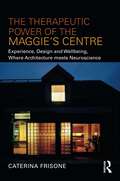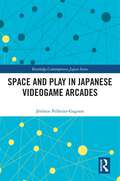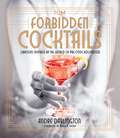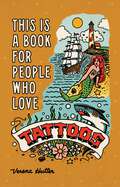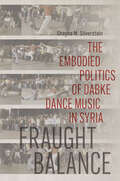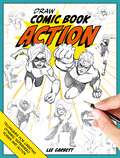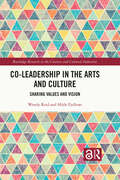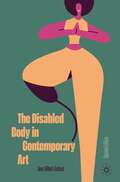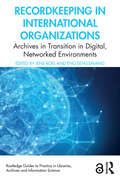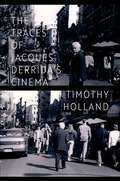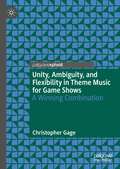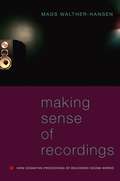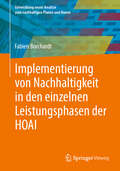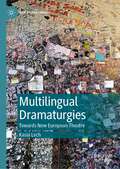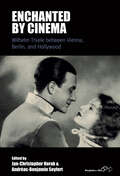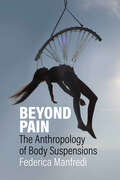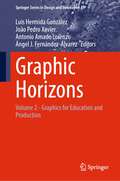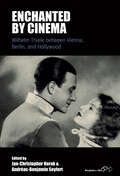- Table View
- List View
The Therapeutic Power of the Maggie’s Centre: Experience, Design and Wellbeing, Where Architecture meets Neuroscience
by Caterina FrisoneThis book is about the therapeutic environment of the Maggie’s centre and explores the many ways this is achieved. With an unconventional architecture as required by the design brief, combined with Maggie’s psychological support programme, this special health facility allows extraordinary therapeutic effects in people, to the point that one can speak of therapeutic power.After tracing the story of the Maggie’s centre, the book reveals its fundamentals: Maggie’s Therapeutikos (the-mind-as-important-as-the-body), the Architectural Brief and the ‘Client-Architect-Users’ Triad. It continues by unfolding Maggie’s synergy-that between people and place-which increases users’ psychological flexibility helping them tolerate what was intolerable before. Although comfort and atmospheres are paramount, they are not enough to define the therapeutic environment of the Maggie’s centre. Only by looking at neuroscience that can give us scientific explanations of empathy, feelings and emotions and only considering space neither neutral nor empty, but full of forces that envelop people in an embodied experience, can we explain what generates wellbeing in a Maggie’s centre.The book concludes by critically evaluating the Maggie’s centre as a model to be applied to other healthcare facilities and to architecture in general. It is essential reading for any student or professional working on therapeutic environments.
The Therapeutic Power of the Maggie’s Centre: Experience, Design and Wellbeing, Where Architecture meets Neuroscience
by Caterina FrisoneThis book is about the therapeutic environment of the Maggie’s centre and explores the many ways this is achieved. With an unconventional architecture as required by the design brief, combined with Maggie’s psychological support programme, this special health facility allows extraordinary therapeutic effects in people, to the point that one can speak of therapeutic power.After tracing the story of the Maggie’s centre, the book reveals its fundamentals: Maggie’s Therapeutikos (the-mind-as-important-as-the-body), the Architectural Brief and the ‘Client-Architect-Users’ Triad. It continues by unfolding Maggie’s synergy-that between people and place-which increases users’ psychological flexibility helping them tolerate what was intolerable before. Although comfort and atmospheres are paramount, they are not enough to define the therapeutic environment of the Maggie’s centre. Only by looking at neuroscience that can give us scientific explanations of empathy, feelings and emotions and only considering space neither neutral nor empty, but full of forces that envelop people in an embodied experience, can we explain what generates wellbeing in a Maggie’s centre.The book concludes by critically evaluating the Maggie’s centre as a model to be applied to other healthcare facilities and to architecture in general. It is essential reading for any student or professional working on therapeutic environments.
Space and Play in Japanese Videogame Arcades (Routledge Contemporary Japan Series)
by Jérémie Pelletier-GagnonThis book presents a scholarly investigation of the development and culture of Japanese videogame arcades, both from a historical and contemporary point of view.Providing an overview of the historical evolution of public amusement spaces from the early rooftop amusement spaces from the early nineteenth century to the modern multi‑floor and interconnected arcade complexes that characterize the urban fabric of contemporary Japan, the book argues that arcade videogames and their associated practices must be examined in the context in which they are played, situated in the interrelation between the game software, the cabinets as material conditions of play, and the space of the venue that frames the experience. Including three case studies of distinct and significant game centres located in Tokyo and Kyoto, the book addresses of play in public, including the notion of performance and observation as play practices, spatial appropriation, as well as the compartmentalization of the play experience.In treating videogames as sets of circumstances, the book identifies the opportunities for ludic practices that videogame arcades provide in Japan. As such, it will appeal to students and scholars of Game Studies and Digital Media Studies, as well as those of Japanese Culture and Society.
Space and Play in Japanese Videogame Arcades (Routledge Contemporary Japan Series)
by Jérémie Pelletier-GagnonThis book presents a scholarly investigation of the development and culture of Japanese videogame arcades, both from a historical and contemporary point of view.Providing an overview of the historical evolution of public amusement spaces from the early rooftop amusement spaces from the early nineteenth century to the modern multi‑floor and interconnected arcade complexes that characterize the urban fabric of contemporary Japan, the book argues that arcade videogames and their associated practices must be examined in the context in which they are played, situated in the interrelation between the game software, the cabinets as material conditions of play, and the space of the venue that frames the experience. Including three case studies of distinct and significant game centres located in Tokyo and Kyoto, the book addresses of play in public, including the notion of performance and observation as play practices, spatial appropriation, as well as the compartmentalization of the play experience.In treating videogames as sets of circumstances, the book identifies the opportunities for ludic practices that videogame arcades provide in Japan. As such, it will appeal to students and scholars of Game Studies and Digital Media Studies, as well as those of Japanese Culture and Society.
Gudetama Cross-Stitch: 30 Easy-to-Follow Patterns from Your Favorite Lazy Egg
by Sosae Caetano Dennis CaetanoGudetama Cross-Stitch combines cross-stitching fun with 30 easy-to-follow patterns inspired by everyone's favorite lazy egg with the can't-be-bothered attitude. Gudetama&’s name literally translates to &“lazy egg,&” and it&’s how we all feel sometimes when it comes to, well, pretty much anything. But if you&’re the kind of person who doesn&’t have time for complicated crafts or dealing with other people, then this collection of 30 Gudetama-inspired designs are just for you. First, you&’ll learn cross-stitching basics including tools and techniques and how to read a cross-stitch chart. Then you&’ll apply your new skills to a range of hilarious and lovable patterns organized into chapters like Lazy, Medium-Lazy, and Pay Attention—depending on how sluggish or motivated you&’re feeling. Finally, you&’ll be able to apply your masterpieces to projects like gift tags, greeting cards, and ornaments. Whether you&’re an experienced cross-stitcher or new to the craft, you&’ll find a variety of poses and patterns in this book that are accessible and easy to learn. With a little patience and practice, anyone can bring these Gudetama-inspired masterpieces to life. And if not, just take a nap.
Forbidden Cocktails: Libations Inspired by the World of Pre-Code Hollywood
by André DarlingtonA stunning package for classic film buffs and drinks enthusiasts alike, all the &“forbidden&” fun of Pre-Code Hollywood and the Prohibition and speakeasy era meet in this stylish cocktail book. What might Jean Harlow have sipped for Dinner at Eight? What did Barbara Stanwyck take to steel herself in Baby Face? If you&’re a classic film fan who&’s ever pondered these questions, or are a bartender or at-home entertainer who adores Prohibition-era cocktails, this guide to mixed drinks inspired by Pre-Code Hollywood is essential reading. The stars and stories of the &“forbidden&” time in moviemaking before strict censorship was enforced and the movies reflected a raucous freedom that would be unseen again for decades take the spotlight in Forbidden Cocktails. With 50 film-and-drink pairings and packaged handsomely with more than 100 full-color and black-and-white photos throughout, this is a practical and stunning homage to a singularly exuberant and evocative era. Movie-and-cocktail pairings include: The Divorcee / Balanced Account; Hell&’s Angels / Platinum Blonde; Dracula / Count Draiquiri; Strangers May Kiss / Stranger&’s Kiss; The Public Enemy / Tom Powers; Night Nurse / My Pal Rye; Shanghai Express / Shanghai Lily; Scarface / First Ward; One Way Passage / Passage to Paradise; Trouble in Paradise / Lubitsch Touch; Call Her Savage / Greenwich Village; Sign of the Cross / Naked Moon; Gold Diggers of 1933 / Pettin&’ in the Park; Flying Down to Rio / Hotel Hibiscus; It Happened One Night / It Happened One Morning; The Thin Man / Asta
This is a Book for People Who Love Tattoos
by Verena HutterJourney from ink to skin with This Is a Book for People Who Love Tattoos, a glorious full-color celebration of the history and craft of tattooing. From the earliest known origins of tattooing to the latest trends, this gorgeously illustrated guide offers a deep look at the culture of American Traditional style tattoos. Tattoo aficionado and historian Verena Hutter profiles not just the key tattoo artists who inspired the style, such as Sailor Jerry, Bert Grimm, and Dainty Dottie, but also the meanings and origins behind some of the most iconic designs found in tattoo shops across the globe She traces the indelible &“I love Mom&” tattoo back to a 19th-century folk song sung by Irish sailors and reveals the significance of eagles, skulls, horseshoes, lighthouses, and dozens of other designs. This Is a Book for People Who Love Tattoos will inspire your next tattoo session while celebrating the rich history of the craft.
Fraught Balance: The Embodied Politics of Dabke Dance Music in Syria (Music / Culture)
by Shayna M. SilversteinDabke, one of Syria's most beloved dance music traditions, is at the center of the country's war and the social tensions that preceded conflict. Drawing on almost two decades of ethnographic, archival, and digital research, Shayna M. Silverstein shows how dabke dance music embodies the fraught dynamics of gender, class, ethnicity, and nationhood in an authoritarian state. The book situates dabke politically, economically, and historically in a broader account of expressive culture in Syria's recent (and ongoing) turmoil. Silverstein shows how people imagine the Syrian nation through dabke, how the state has coopted it, how performances of masculinity reveal—and play with—the tensions and complexities of the broader social imaginary, how forces opposed to the state have used it resistively, and how migrants and refugees have reimagined it in their new homes in Europe and the United States. She offers deeply thoughtful reflections on the ethnographer's ethical and political dilemmas on fieldwork in an authoritarian state. Silverstein's study ultimately questions the limits of authoritarian power, considering the pleasure and play intrinsic to dabke circles as evidence for how performance cultures sustain social life and solidify group bonds while reproducing the societal divides endemic to Syrian authoritarianism.
Draw Comic Book Action: Techniques for creating dynamic superhero poses and action
by Lee GarbettWhat does every aspiring comic artist REALLY want to draw? Action, of course!Learn how to render all aspects of adrenalin-filled movement, from jaw-dropping superhero antics to kick-ass fistfights. The hallmark of the comic book, the action is what draws a reader in and keeps them hungry for more – in this classic guide all the skills you need to make your action fast-paced and full of movement are laid out on the page, from one of the best creators working in comics today.Techniques for drawing every dynamic action are explained, from body contact and flying through to fistfights, group rumbles and full-on battles.Clever exercises show how to achieve convincing movement, from dynamic standing poses, to running, swinging, flying and fighting.An Action File of comic character drawings in dynamic poses forms an invaluable resource for practice and reference, making drawing action the easiest thing in the world!
Co-Leadership in the Arts and Culture: Sharing Values and Vision (Routledge Research in the Creative and Cultural Industries)
by Wendy Reid Hilde FjellværThis book is about co-leadership: A leadership practice and structure often found in arts organizations that consist of two or three executives who bridge the art and business divide at the top.Many practitioners recognize this phenomenon but the research on this topic is limited and dispersed. This book assembles a coherent overview and presents new insights of the field. While co-leadership is well institutionalized in the West, it is also criticized for management’s constraint of artistic autonomy and for its pluralism that dilutes leadership clarity. However, co-leadership also personifies the strategic objectives of art, audiences, organization, and community, by addressing plural logics – navigating the demands of artistic vision and organizational stability. It is an integrating solution. The authors investigate its specifics in the arts, including global practice and its interdisciplinary nature. The theoretical frame of plural leadership supports their empirical explorations of the dynamics within the co-leadership relationship and with organizational stakeholders. Data includes the voices of co-leaders, artists, staff, and board members from arts organizations in Canada and Norway. Their abductive reflection generates a stimulating research experience.By viewing co-leadership in action, not as a study of static theories, the book will appeal not only to students and researchers but also resonate with practitioners in arts and cultural management and assist them to work with co-leadership and to manage its tensions.
The Disabled Body in Contemporary Art
by Ann Millett-GallantThe second edition offers an essential update to the foundational first edition, The Disabled Body in Contemporary Art. Featuring updated chapters and case studies, this second edition will not only expand on the first edition but will bring a new focus to contemporary disabled artists and their embodied, multimedia work.
Recordkeeping in International Organizations: Archives in Transition in Digital, Networked Environments (Routledge Guides to Practice in Libraries, Archives and Information Science)
by Jens Boel Eng SengsavangRecordkeeping in International Organizations offers an important treatment of international organizations from a recordkeeping perspective, while also illustrating how recordkeeping can play a vital role in our efforts to improve global social conditions.Demonstrating that organizations have both a responsibility and an incentive to effectively manage their records in order to make informed decisions, remain accountable to stakeholders, and preserve institutional history, the book offers practical insights and critical reflections on the effective management, protection, and archiving of records. Through policy advice, surveys, mind mapping, case studies, and strategic reflections, the book provides guidance in the areas of archives, records, and information management for the future. Among the topics addressed are educational requirements for recordkeeping professionals, communication policies, data protection and privacy, cloud computing, classification and declassification policies, artificial intelligence, risk management, enterprise architecture, and the concepts of extraterritoriality and inviolability of archives. The book also offers perspectives on how digital recordkeeping can support the UN’s 2030 Agenda for Sustainable Development, and the accompanying Sustainable Development Goals (SDGs).Recordkeeping in International Organizations will be essential reading for records and archives professionals, information technology, legal, security, management, and leadership staff, including chief information officers. The book should also be of interest to students and scholars engaged in the study of records, archives, and information management, information technology, information security, and law.Chapters 7 and 9 of this book are freely available as a downloadable Open Access PDF at http://www.taylorfrancis.com under a Attribution-NonCommercial-ShareAlike (CC-BY-NC-SA) 4.0 license
The Traces of Jacques Derrida's Cinema
by Timothy HollandSituated at the intersection of film and media studies, literary theory, and continental philosophy, The Traces of Jacques Derrida's Cinema provides a trenchant account of the role of cinema in the oeuvre of one of the most influential philosophers of the twentieth century, Jacques Derrida (1930-2004). The book is animated by Derrida's self-confessed passion for the movies, his reluctance to write about film despite the range of his corpus, and the generative encounters arising between his legacy and the field of film and media studies as a result. Given the expanse of its references, interdisciplinarity, and consideration of Derrida's approach to the experience of both spectatorship and the act of being filmed, The Traces of Jacques Derrida's Cinema contributes to the ongoing close analyses of the philosopher's work while also providing a rigorous introduction to deconstruction. Author Timothy Holland interweaves historical and speculative modes of research and writing to articulate the peripheral-yet surprisingly crucial-place of the cinematic medium for Derrida and his philosophical enterprise. The outcome is a meticulously detailed survey of the centers and margins of Derrida's oeuvre that include forays into such terrain as: his notable appearances in films; an unrealized project on cinema and belief that Derrida proposed in a 2001 interview; the correspondences between the strategies of deconstruction and the traditions, homecomings, and wordplay of David Lynch's cinematic media; and the questions wedded to the future of film studies amid the vicissitudes of the modern, virtual university. Ultimately, Holland pursues the thinking activated by the flickering of Derrida's cinema-not only the absence and presence of film in Derrida's professional and personal life, but also the rigor of academic discourse and the pleasures of the movies, ghosts and technology, religious faith and scientific knowledge, and ruination and survival-as a critical chance for reflection.
The Buildings of the Malting Industry: The production of malt from prehistory to the 21st century
by Amber PatrickThe Buildings of the Malting Industry is a fascinating book on the buildings that have helped make our much loved beer over the centuries. Malt is one of the main ingredients of beer, yet the buildings in which it was and is now produced have received very little attention, although most towns and many villages had their own malthouse and kiln. This is the first book to address the paucity of detail on maltings which historically were to be found in all English counties. Today evidence for a malthouse may just be a name on a building or street. However, where they survive the pyramidal roofs clearly demonstrate the presence of a malthouse as do other less recognisable features. This book gives details of early malt kilns and shows how they changed over the centuries. Early buildings were essentially vernacular ones but by the mid-19th century some firms were using specialist architects. Then in the 20th century there was more engineering input to new maltings, in particular with the development of the pneumatic process. This once widespread industry is now mainly confined to the eastern side of the country. Elsewhere surviving maltings have been converted to other uses and examples of these are given. There are illustrations of the exteriors and interiors of malthouses and kilns which show some of the developments and how some buildings have been reused.
Unity, Ambiguity, and Flexibility in Theme Music for Game Shows: A Winning Combination
by Christopher GageWith flashing lights, bright colors, and big money, game shows have been an integral part of American culture since the days of radio. While the music that accompanies game shows is charming and catchy, it presents two unique, opposing challenges: first, it must exhibit unity in its construction so that, at any point and for any length of time, it is a tuneful, recognizable signifier of the show to which it belongs; at the same time, it must also possess the ability to be started and stopped according to the needs of gameplay without seeming truncated. This book argues that game show music, in particular from 1960 to 1990, deploys a variety of shared techniques in order to manage these two goals, including theme-derived vamps; saturation of motivic material; and harmonic, rhythmic, and formal ambiguity. Together, these techniques make game show themes exciting, memorable, and perfectly suited to their role.
Quick Guide Nachhaltigkeit in der Immobilienwirtschaft: Wie Sie die ESG-Kriterien in der Immobilienbranche richtig anwenden (Quick Guide)
by Christoph StraubeDieses Buch erklärt, was die ESG-Kriterien Umwelt, Soziales und Governance für die Immobilienbranche bedeuten und wie Unternehmen nachhaltiges Wirtschaften in der Praxis umsetzen können. Der Autor erläutert anschaulich die Auswirkungen in verschiedenen Bereichen, etwa in der Projektentwicklung, der Investitionsplanung, bei Maklern oder im Gebäudemanagement. Darüber hinaus wirft er einen fokussierten Blick auf digitale Lösungen bei der Umsetzung von ESG-Anforderungen und erläutert warum das Thema in Zukunft ganz oben auf die Agenda von Immobilienunternehmen rücken muss
Making Sense of Recordings: How Cognitive Processing of Recorded Sound Works
by Mads Walther-HansenBuilding on ideas from cognitive metaphor theory, Making Sense of Recordings offers a new perspective on record production, music perception, and the aesthetics of recorded sound. It shows how the language about sound is intimately connected to sense-making - both as a reflection of our internal cognitive capacities and as a component of our extended cognitive system. In doing so, the book provides the foundation for a broader understanding of the history of listening, discourses of sound quality, and artistic practices in the age of recorded music. The book will be of interest to anyone who asks how recorded music sounds and why it sounds as it does, and it will be a valuable resource for musicology students and researchers interested in the analysis of sound and the history of listening and record production. Additionally, sound engineers and laptop musicians will benefit from the book's exploration of the connection between embodied experiences and our cognitively processed experiences of recorded sound. The tools provided will be useful to these and other musicians who wish to intuitively interact with recorded or synthesized sound in a manner that more closely resembles the way they think and that makes sense of what they do.
Implementierung von Nachhaltigkeit in den einzelnen Leistungsphasen der HOAI (Entwicklung neuer Ansätze zum nachhaltigen Planen und Bauen)
by Fabien BorchardtDas Buch bietet einen allgemeingültigen Leitfaden zur Implementierung von Nachhaltigkeitsaspekten in den einzelnen Leistungsphasen der HOAI. Dieser Leitfaden bezieht sich auf die Planung, Ausführung, Bewirtschaftung und Verwertung eines Neubaus hinsichtlich öffentlicher Gebäude. Die Inhalte und Beiträge des Leitfadens werden durch eine ausführliche Untersuchung des derzeitigen Standes der Technik und der Forschung angefertigt. Dabei werden die derzeitigen Regelwerke bzw. gültigen Standards, Bewertungs- und Zertifizierungssysteme, aktuelle Forschungsarbeiten sowie existierende Leitfäden begutachtet und für die eigene Arbeit bewertet. Der thematische Schwerpunkt dieser Arbeit liegt auf der anschließenden Entwicklung eines Leitfadens, welcher Nachhaltigkeitskriterien für die unterschiedlichen Stakeholder eines öffentlichen Bauvorhabens sowie deren Leistungsphasen gemäß HOAI festlegt. Die Nachhaltigkeitskriterien orientieren sich an der Optimierung der ökologischen, ökonomischen, soziokulturellen und technischen Qualität sowie an der Prozess- und Standortqualität des zu erstellenden Gebäudes. Neben den Leistungsphasen nach HOAI werden ebenso die „Phase 0“ sowie „Phase 10“ betrachtet. Somit soll eine ganzheitliche lebenszyklusorientierte Betrachtung eines Gebäudes durch den Leitfaden ermöglicht werden. Der Leitfaden stellt die allgemeine Vorgehensweise und Methodik zur Implementierung von Nachhaltigkeitsaspekten in der Planung, Ausführung, Bewirtschaftung und Verwertung eines Neubaus dar. Mit Hilfe der Erstellung des allgemeingültigen Leitfadens für öffentliche Bauvorhaben soll eine Grundlage für die Erstellung eines nachhaltigen Neubaus geschaffen werden. Ein abgeschlossenes Bauvorhaben wird mit dem erstellten Leitfaden evaluiert. Hierbei wird auf die Verbesserungspotentiale zur Implementierung weiterer Nachhaltigkeitsaspekte für zukünftige Bauprojekte öffentlicher Auftraggeber eingegangen.
Multilingual Dramaturgies: Towards New European Theatre (New Dramaturgies)
by Kasia LechMultilingual Dramaturgies provides a study of dramaturgical practices in contemporary multilingual theatre in Europe. Featuring interviews with international theatremakers, the book gives an insight into diverse approaches towards multilingual theatre and its dramaturgy that reflect cultural, political, and economic landscapes of contemporary Europe, its inhabitants, and its theatres. First-hand accounts are contextualized to reveal a complex set of negotiations involved in the creative and political tasks of staging multilingualism and engaging the audience, as well as in practical issues like funding and developing working models. Using interviews with practitioners from a diverse range of theatrical backgrounds and career levels, and with various models of financial support, Multilingual Dramaturgies also offers an insight into different attitudes towards multilingualism in European theatres. The book illuminates not only the potential for multilingual dramaturgies, but also the practical and creative difficulties involved in making them. By bringing the voices of artists together and providing a critical commentary, the book reveals multilingual dramaturgies as webbed practices of differences that also offer new ways of understanding and performing identity in a European context. Multilingual Dramaturgies sheds light on an exciting theatre practice, argues for its central role in Europe and highlights potential directions for its further development.
Enchanted by Cinema: Wilhelm Thiele between Vienna, Berlin, and Hollywood (Film Europa #29)
by Jan-Christopher Horak and Andréas-Benjamin SeyfertWilliam Thiele is remembered today as the father of the sound film operetta with seminal classics such as Drei von der Tankstelle (1930). While often considered among the most accomplished directors of Late Weimar cinema, as an Austrian Jew he was vilified during the onset of the Nazi regime in 1933 and fled to the United States where he continued making films until the end of his career in 1960. Enchanted by Cinema closely examines the European musical film pioneer’s work and his cross-cultural perspective across forty years of filmography in Berlin and Hollywood to account for his popularity while discussing issues of ethnicity, exile, comedy, music, gender, and race.
Beyond Pain: The Anthropology of Body Suspensions
by Federica ManfrediThe practice of body suspension — piercing one’s own flesh with metal hooks and hanging from them — and its uniquely sprawling community challenge our cultural understanding of pain. The suspendees experience physical suffering to trigger altered states of consciousness that help them define and create an enhanced version of the self. Through experimental and practice-based methodology, Beyond Pain combines thirteen years of intermittent ethnographical fieldwork during suspension festivals and private events in Italy, Portugal, and Norway, along with online sites such as Facebook groups, to uncover the often silenced and misunderstood voices of the people who undertake this practice.
Graphic Horizons: Volume 2 - Graphics for Education and Production (Springer Series in Design and Innovation #43)
by Luis Hermida González João Pedro Xavier Antonio Amado Lorenzo Ángel J. Fernández-ÁlvarezThis book reports on several advances in architectural graphics, with a special emphasis on education, training, and architectural production. It gathers a selection of contributions to the 20th International Congress of Architectural Graphic Expression, EGA 2024, held on May 27-29, 2024, in Porto, Portugal, with the motto: "Graphic Horizons". This is the second of a 3-volume set.
Enchanted by Cinema: Wilhelm Thiele between Vienna, Berlin, and Hollywood (Film Europa #29)
by Jan-Christopher Horak Andréas-Benjamin SeyfertWilliam Thiele is remembered today as the father of the sound film operetta with seminal classics such as Drei von der Tankstelle (1930). While often considered among the most accomplished directors of Late Weimar cinema, as an Austrian Jew he was vilified during the onset of the Nazi regime in 1933 and fled to the United States where he continued making films until the end of his career in 1960. Enchanted by Cinema closely examines the European musical film pioneer’s work and his cross-cultural perspective across forty years of filmography in Berlin and Hollywood to account for his popularity while discussing issues of ethnicity, exile, comedy, music, gender, and race.
Enchanted by Cinema: Wilhelm Thiele between Vienna, Berlin, and Hollywood (Film Europa #29)
by Jan-Christopher Horak Andréas-Benjamin SeyfertWilliam Thiele is remembered today as the father of the sound film operetta with seminal classics such as Drei von der Tankstelle (1930). While often considered among the most accomplished directors of Late Weimar cinema, as an Austrian Jew he was vilified during the onset of the Nazi regime in 1933 and fled to the United States where he continued making films until the end of his career in 1960. Enchanted by Cinema closely examines the European musical film pioneer’s work and his cross-cultural perspective across forty years of filmography in Berlin and Hollywood to account for his popularity while discussing issues of ethnicity, exile, comedy, music, gender, and race.
Beyond Pain: The Anthropology of Body Suspensions
by Federica ManfrediThe practice of body suspension — piercing one’s own flesh with metal hooks and hanging from them — and its uniquely sprawling community challenge our cultural understanding of pain. The suspendees experience physical suffering to trigger altered states of consciousness that help them define and create an enhanced version of the self. Through experimental and practice-based methodology, Beyond Pain combines thirteen years of intermittent ethnographical fieldwork during suspension festivals and private events in Italy, Portugal, and Norway, along with online sites such as Facebook groups, to uncover the often silenced and misunderstood voices of the people who undertake this practice.
